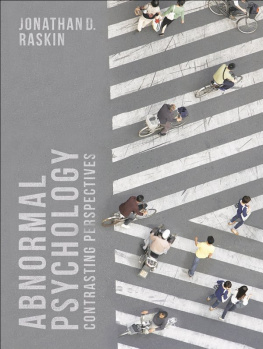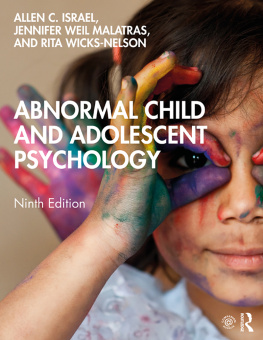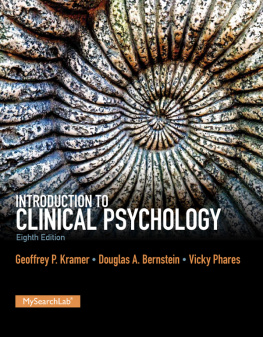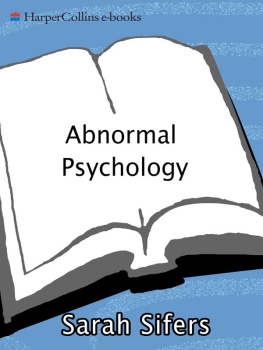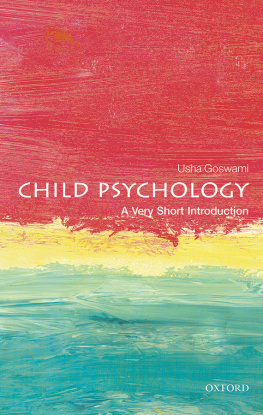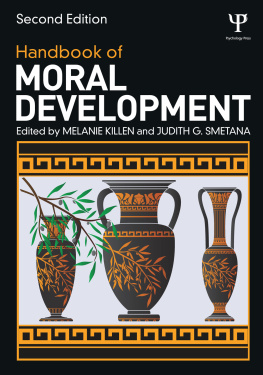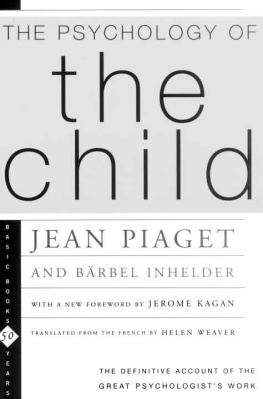Advanced Abnormal Child Psychology
Second Edition
Advanced Abnormal Child Psychology
Second Edition
Edited by
Michel Hersen
Pacific University
Robert T.Ammerman
Childrens Hospital and Medical Center, Cincinnati
This edition published in the Taylor & Francis e-Library, 2009.
To purchase your own copy of this or any of Taylor & Francis or Routledges collection of thousands of eBooks please go to www.eBookstore.tandf.co.uk.
Copyright 2000 by Lawrence Erlbaum Associates, Inc.
All rights reserved. No part of this book may be reproduced in any form, by photostat, microfilm, retrieval system, or any other means, without prior written permission of the publisher.
Lawrence Erlbaum Associates, Inc., Publishers
10 Industrial Avenue
Mahwah, NJ 07430
Cover design by Kathryn Houghtaling Lacey
Library of Congress Cataloging-in-Publication Data
Advanced abnormal child psychology/edited by Michel Hersen,
Robert T.Ammerman.2nd ed.
p. cm.
Includes bibliographical references and index.
ISBN 0-8058-2866-4 (cloth: alk. paper)
ISBN 0-8058-2867-2 (pbk: alk. paper)
I. Child psychopathology. 2. Child psychiatry. I. Hersen, Michel.
II. Ammerman, Robert T.
[DNLM: 1. Mental DisordersChild. 2. Mental DisordersInfant.
3. Child Psychology. WS 350 A2438 1999]
RJ499.A327 1999
618.9289dc21
DNLM/DLC
for Library of Congress 9938242
CIP
ISBN 1-4106-0532-9 Master e-book ISBN
Preface
There was a time when abnormal child psychology was the stepchild of abnormal psychology, with perhaps one or two chapters in an entire advanced textbook devoted to children. Given the explosive amount of new research on child development in general since the 1980s, the stepchild is obviously no longer a valid characterization. Indeed, in the last 15 years, many new journals devoted to childhood problems have made their appearance on library bookshelves. Although several books reviewing childhood problems were published, none, in our opinion, had sufficient breadth to show the advanced undergraduate and beginning graduate student the extent of our existing knowledge base concerning the disorders that manifest themselves early in development. Therefore, we undertook the task of assembling the first edition of this text, in an effort to integrate the empirical and clinical literatures. Since its publication in 1995, a great deal more work has been done.
This revised and expanded second edition includes much new material from the first edition authors and from three new ones, all respected experts in the field. It is divided into three parts, each preceded by a unifying introduction based on material in the chapter and the authors conclusions. In Part I, General Issues, students are given a firm grounding and meaningful context for the information presented in parts II and III. Chapter 1 (Historical Overview) reviews the historical developments, essentially documenting both the neglect and abuse that children suffered at the hands of society well into the 20th century. Chapter 2 (Diagnosis and Classification) reviews the salient issues relating to classification and diagnosis of childhood disorders, including new developments in the Diagnostic and Statistical Manual of Mental Disorders (4th ed.). Chapter 3 (Epidemiologic Considerations) familiarizes the student with epidemiologic principles. Chapter 4 (Development and Psychopathology) underscores how developmental psychopathology provides a theoretical framework that can guide research and clinical efforts. Chapter 5 (Psychophysiological Research on Childhood Psychopathology) looks at psychophysiological determinants of behavior, with special attention focused on childhood autism, attention deficit disorder, and antisocial/conduct disorder. Chapter 6 (Familial Determinants) carefully looks at the evidence detailing familial factors that are contributory to child psychopathology. Chapter 7 (Research Strategies in Child Psychopathology) reviews the theoretical, methodological, and practical considerations involved in determining the course a researcher will take when investigating a problem in child psychopathology. Finally, chapter 8 (Psychological Aspects of Pediatric Disorders) details reactions of children, families, and society to complex and diverse child health problems.
As the title indicates, Part II focuses on assessment and treatment foundational issues often given short shrift in textbooks; here, they are discussed thoroughly from an empirical perspective. Chapter 9 (Intellectual and Cognitive Assessment), with a particular emphasis on traditional intelligence tests, provides an in-depth coverage of test development, administration, and interpretation of results. Chapter 10 (Behavioral Assessment) contrasts the philosophical and procedural differences between behavioral and other forms of psychological assessment. Chapter 11 (Behavioral Treatment) reviews the most commonly used behavioral techniques. Multiple case examples are provided to illustrate how behavioral treatments are implemented. Chapter 12 (Psychopharmacological Treatment) examines specific psychiatric disorders for which pharmacotherapy shows promise, including conduct disorder, depression, and developmental disorders. The final chapter in Part III (Community, Prevention, and Wellness) reviews various types of preventative interventions, concluding with an illustration of prevention principles involving conduct disorder and major depression.
In part III, Description of the Disorders, a common organizational format for the discussion of numerous case examples facilitates students comprehension and sparks their interest. This is the general format for each chapter in Part III:
- Clinical Description
- Causes of the Disorder(s)
- Course of the Disorder(s)
- Familial Contributions
- Psychophysiological and Genetic Influences
- Current Treatments (with Case Illustrations)
- Summary
In light of the wealth of information to which we are attempting to do justice, we opted to have experts in each area contribute to the effort. We thank our eminent contributors and colleagues for sharing with us and readers their views on what has been accomplished and where the field now is going. Next, we thank Carole Londere, Alexander Duncan, and Erika Qualls for their technical contributions to the book. Finally, but hardly least of all, we thank our friends at Lawrence Erlbaum Associates for their encouragement and good cheer throughout the process of bringing to fruition this multiauthored textbook.
Michel Hersen Robert
T.Ammerman
PART I
General Issues
When compared to the rest of abnormal psychology, the history of abnormal child psychology is relatively brief. Indeed, the major findings in the field only can be traced to the last three to four decades. And within that time span, the most exciting developments have taken place since the 1970s. Although abnormal child psychology is a relatively new subdiscipline, it already has had numerous influences, including developmental psychology; epidemiology; psychophysiology; genetics; psychopathology; and the data-based approaches to assessment, diagnosis, and treatment. Overall, the influences have been of an empirical nature. In a very short time, the exponential growth of this subdiscipline has made the area complex. Given the extent of such complexity, we believe that the student requires a firm grounding in the basics before she or he can have a full understanding of the nuances of psychopathology and its treatment interventions.


